25+ Stunning Physician Shortage in The US Statistics
Below are over 25 physician shortage statistics that help give you an understanding of the different aspects of the situation and how dire it is.

During the 2020 pandemic, the United States saw a shortage of toilet paper, paper towels, meat products, and even vehicles. But, there’s another that’s much more severe: the physician shortage.
How are there not enough doctors? That seems unfathomable.
Well, many doctors are going to retire in the next decade and there aren’t enough medical students to replace all of the retirees.
Not only are the number of doctors declining because of age, but the population in the United States is growing. More babies mean more humans that need to see a doctor more frequently.
The population of the elderly is also increasing. This means that the number of people with heart attacks, cancer, and other diseases that come with old age will go up as well. Not only will these people fill more hospital beds, but there will also be an increase in the demand for specialists. As stated above, many specialists will be retiring soon, so the upcoming demand will collide with a decreasing supply of doctors.
You can see that the issue of physician shortages can spiral out of control. But what are the actual numbers? How bad is the situation going to be?
Below are over 25 physician shortage statistics that help give you an understanding of the different aspects of the situation.
Problems - Doctors
With most stories, there are two sides to this problem. The first side of the physician shortage story is that of the doctor and the health organizations.
The shortage is prominent in surgical specialties and medical specialties, including family physicians and nurse practitioners. This problem is acutely felt in Hawaii County, Hawaii, as seen in point number 4 below.
The issue doesn’t stop with current doctors, it’s also seen in the rate of graduations. The number of new family practitioners has been dwindling and may continue to decrease, making the shortage worse.
There are some positives on this side of the shortage story, though. The number of physicians trained in the US seems like it’s going to increase in the coming years. Physician assistants and nurse practitioners are also projected to grow. But, will it be enough to help curb the shortage?
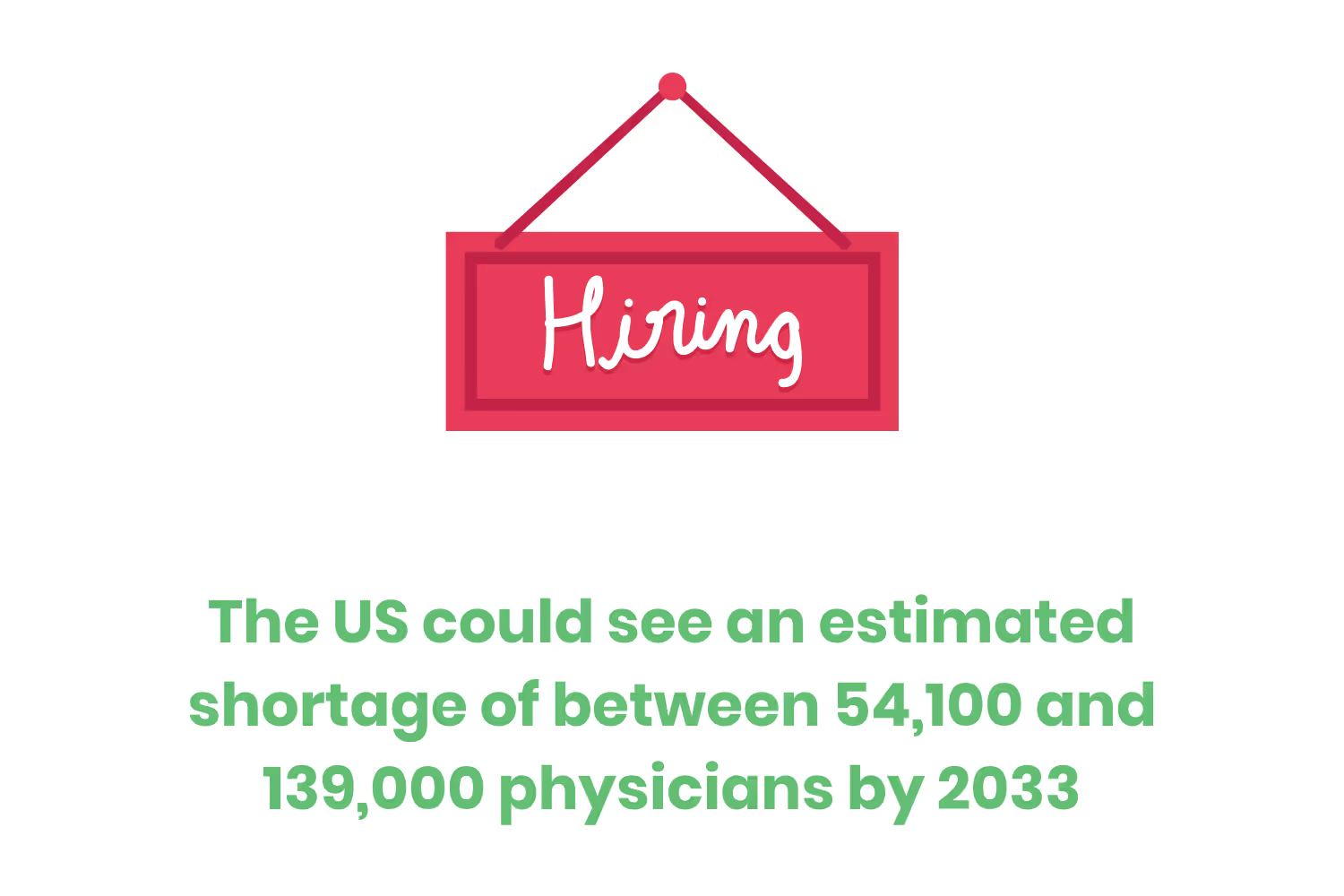
- The US could see an estimated shortage of between 54,100 and 139,000 physicians by 2033. (AAMC)
- Surgical specialties could see an estimated shortage of 15,800 to 30,200 physicians. (AAMC)
- Medical specialties could see an estimated shortage of 3,800 to 13,400 physicians (AAMC)
- Hawaii County has 53% fewer doctors than similar-sized communities in the United States (2020 Hawaii Physician Workforce Assessment)
- Universal access to health care could increase the physician shortage by an additional 31,000 doctors by 2033. (Merritt Hawkins)
- Between 2002 and 2007, the number of U.S. medical school graduates choosing to become family physicians decreased by 25 percent. (Robert Graham Center)
- The AAMC has called for a 30% increase in the number of physicians trained in the U.S. (Merritt Hawkins)
- There are over 115,000 physician assistants and 234,000 nurse practitioners in the U.S., and both roles will probably grow between 30 - 35% in the coming decades. (Medicus News)
Problems - People
The second side of the coin involves the patients. More specifically, the general population in the United States.
Rural areas are acutely impacted by the shortage of doctors. There are fewer doctors in rural areas, which means that it is hard to get an appointment within a reasonable distance.
And the people seem to agree it's a problem. Especially those living in rural areas. Many say that they had trouble finding a doctor. The numbers below suggest that that issue is more widespread than initially thought.
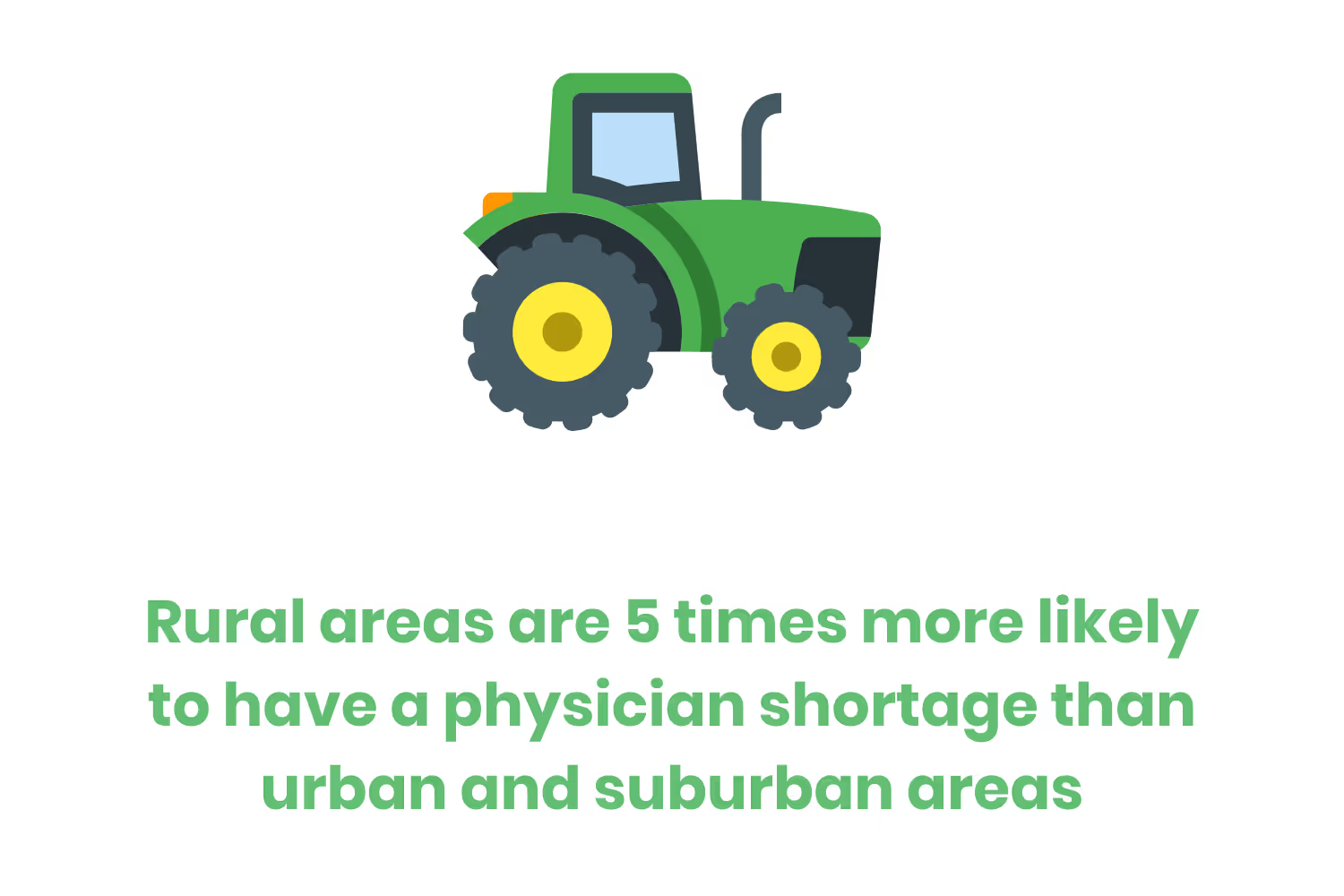
- Rural areas are 5 times more likely to have a physician shortage than urban and suburban areas. (Leverage Rx)
- 65% of voters consistently believe the United States does not have enough doctors to meet the nation’s health care needs. (AAMC)
- 75% of voters living in rural areas feel this way.
- 35% of voters said they had trouble finding a doctor between 2016-2019 (AAMC)
- That’s 10% higher than in 2015.
- 42% of people in rural areas regularly see family physicians. (The Robert Graham Center)
- 23% of all Americans see a family physician. (The Robert Graham Center)
Causes - Age
The age of the workforce is the most obvious cause of the shortage of physicians in the United States.
We can’t prevent doctors from retiring, but there aren’t enough doctors replacing the opening positions. Since these jobs aren’t getting filled fast enough, the deficit is going to continue to get worse.
The situation above could easily lead to burned-out doctors who leave the industry, exasperating the problem.
This issue ranges throughout all medical practices. This includes nurse practitioners, family doctors, and surgeons.
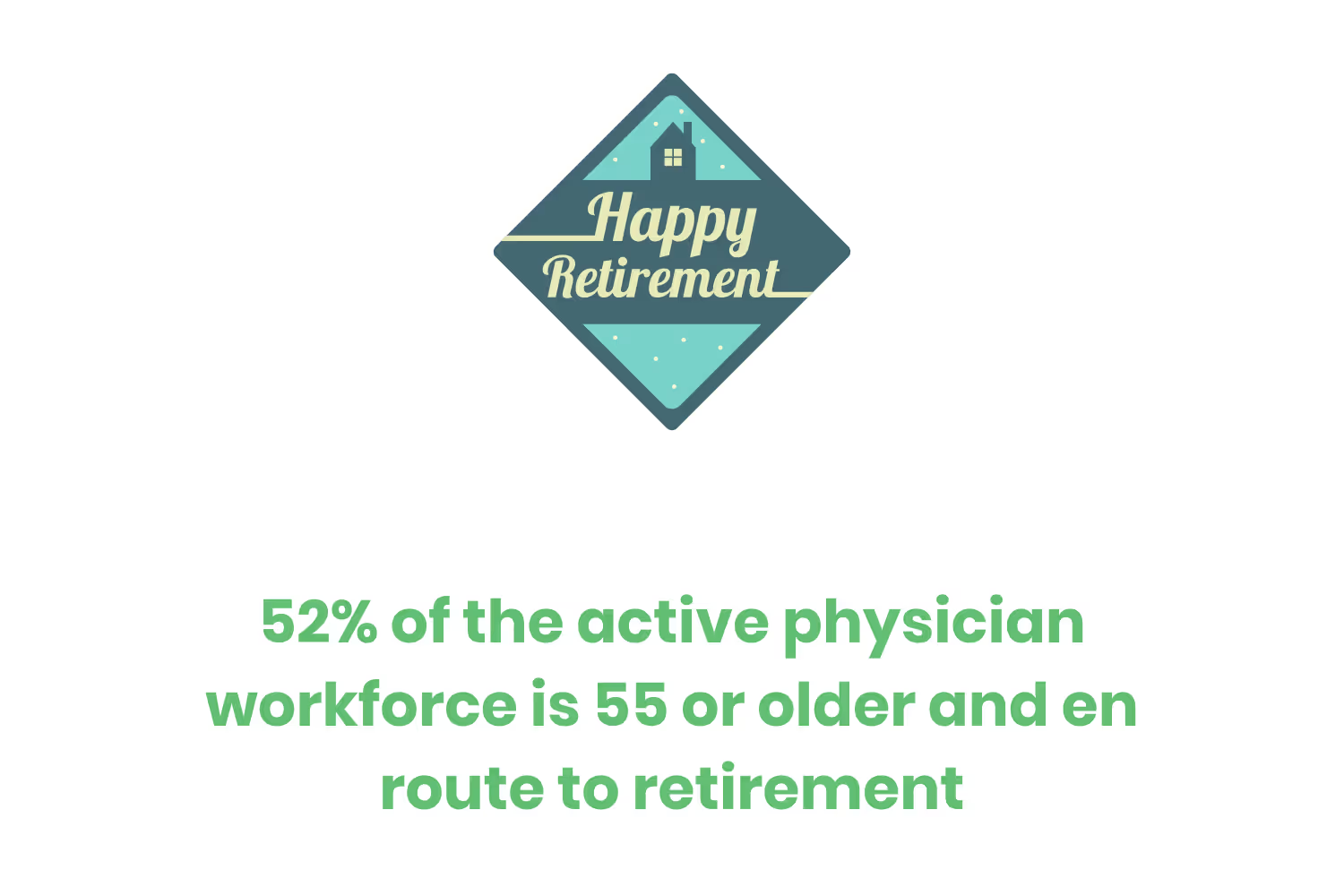
- ~55% of all registered nurses are 50 years old or older. (Definitive Healthcare)
- 52% of the active physician workforce is 55 or older and en route to retirement. (Definitive Healthcare)
- People 55 to 64 made up 26% of the active workforce. (River University)
- People 65 to 75 made up 10% of the active workforce. (River University)
- There were only 767,100 practicing physicians under the age of 75 in 2013. (River University)
- More than 40% of currently active physicians will be 65 or older by 2030. (AAMC)
Causes - Education Rates
Every university endures students who drop out. This is especially true for students in the medical field since it’s so grueling, just take a look at their mental health.
It’s also extremely expensive between bachelor's degrees, master's degrees, and other components of medical education. Many students cannot afford the 8+ years of debt.
The university enrollment rates don’t help the situation and neither does the limited federal funding. These issues limit the number of people who can become doctors, further complicating the shortage situation.
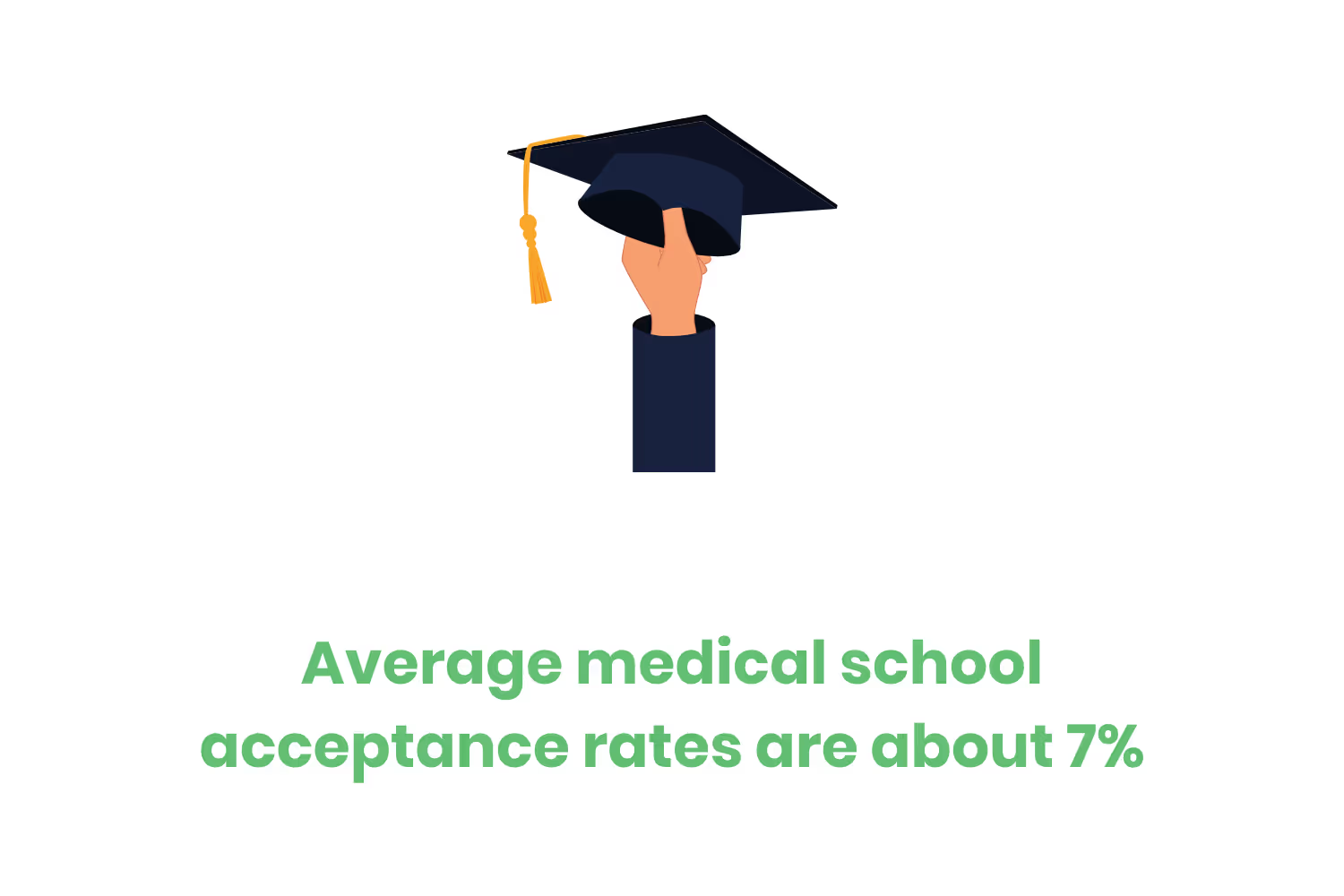
- The Balanced Budget Act of 1997 froze the number of GME slots paid for with federal funds over fears of creating a doctor surplus, and it has remained that way for over 20 years. (US News)
- Medical schools have increased enrollment by nearly 30% between 2002 and 2018, yet funding remained at the 1997 rates. (US News)
- The Resident Physician Shortage Reduction Act of 2019 tried to increase the number of residency positions eligible for Medicare support by 15,000 slots above the previous caps. (American Hospital Association)
- Selective medical schools like Harvard only accept about 3.8% of applicants. (AAMC)
- Average medical school acceptance rates are about 7%. (AAMC)
Causes - Population
The shortage problem is being compounded since the U.S. population, and therefore the demand for doctors continues to grow.
Not only has the population of the United States changed but so has its habits.
People today do not have the same lifestyle that they did 20 years ago. People eat different foods and exercise in different ways.
Some of the changes are for the better. People don’t smoke as much and wear more sunscreen. Unfortunately, some changes are for the worse. Americans have been eating more fast food and obesity has increased.
Therefore, in addition to the sheer increase of the population, the everyday activities of the population affect how many doctors the United States needs.
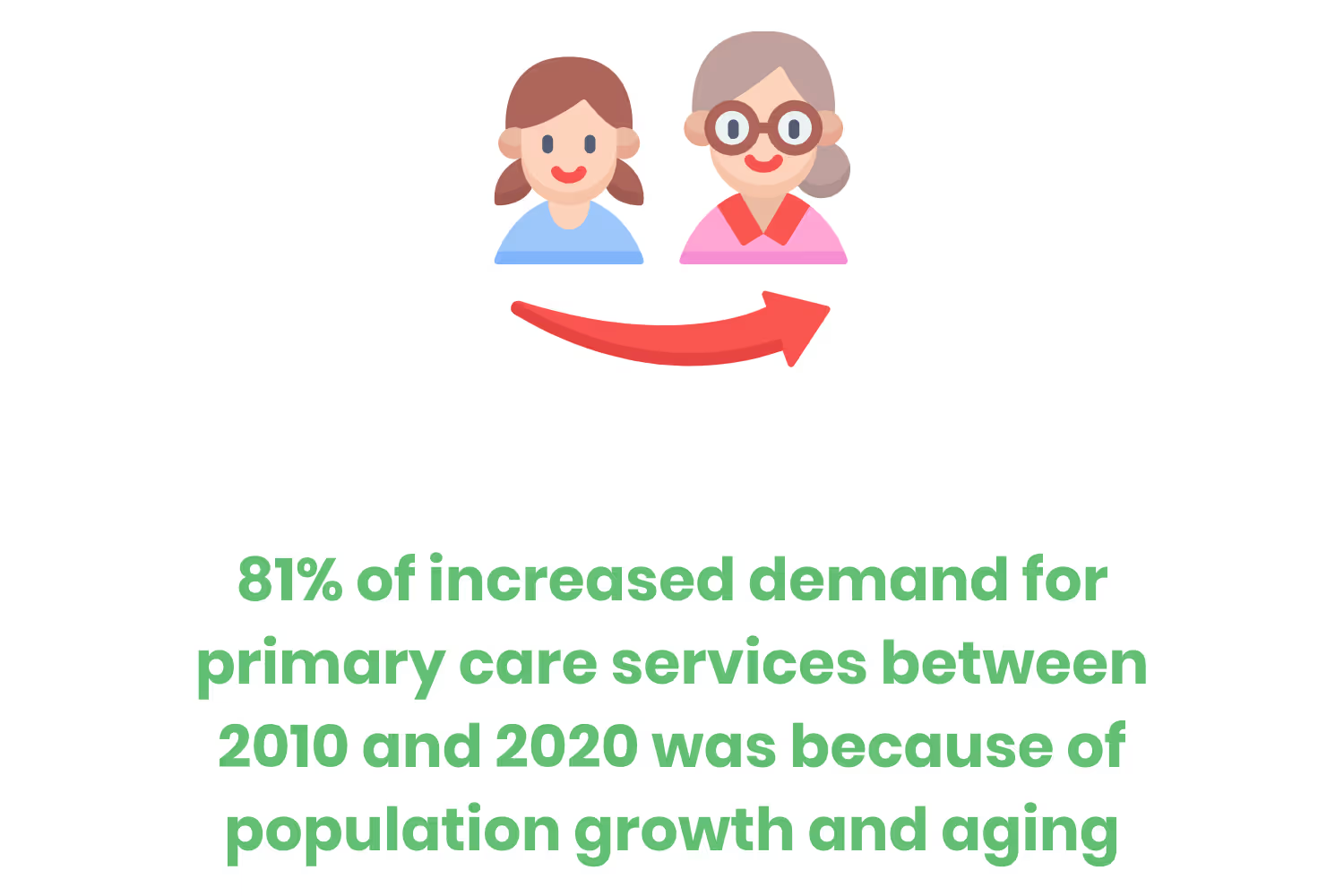
- The population of the U.S. has increased by 50 million. (US News)
- 81% of increased demand for primary care services between 2010 and 2020 was because of population growth and aging. (River University)
- U.S. residents aged 65 and older will probably increase by 55% by 2030. (AAMC)
- People aged 75 and older will most likely grow by 73% by 2030. (AAMC)
- The U.S. population is estimated to grow by more than 10% by 2032. (U.S. Census Bureau)
- People are healthier. Only 14% of all adults 18 years or older smoke cigarettes. (CDC)
- 20 million citizens who were previously uninsured have gained coverage in the first half of 2021. (Leverage Rx)
Conclusion
As you can see, the physician shortage situation isn't ideal. The different causes of the shortage collide with each other and compound to make matters worse.
But, it’s not all bad. There are some positives. As laws change and the government helps fund more students to get a medical degree, the shortage will naturally shrink over time.
The number of physicians in training is growing at a significant rate. Enrollment rates and acceptance rates are also increasing. Physician assistants and nurse practitioners will also see an increase in numbers due to job growth.
Time will tell if the situation gets better or worse. Make sure to keep yourself updated on the number of physicians in your area, your state or province, and in your country in general.
Emphasize your product's unique features or benefits to differentiate it from competitors
In nec dictum adipiscing pharetra enim etiam scelerisque dolor purus ipsum egestas cursus vulputate arcu egestas ut eu sed mollis consectetur mattis pharetra curabitur et maecenas in mattis fames consectetur ipsum quis risus mauris aliquam ornare nisl purus at ipsum nulla accumsan consectetur vestibulum suspendisse aliquam condimentum scelerisque lacinia pellentesque vestibulum condimentum turpis ligula pharetra dictum sapien facilisis sapien at sagittis et cursus congue.
- Pharetra curabitur et maecenas in mattis fames consectetur ipsum quis risus.
- Justo urna nisi auctor consequat consectetur dolor lectus blandit.
- Eget egestas volutpat lacinia vestibulum vitae mattis hendrerit.
- Ornare elit odio tellus orci bibendum dictum id sem congue enim amet diam.
Incorporate statistics or specific numbers to highlight the effectiveness or popularity of your offering
Convallis pellentesque ullamcorper sapien sed tristique fermentum proin amet quam tincidunt feugiat vitae neque quisque odio ut pellentesque ac mauris eget lectus. Pretium arcu turpis lacus sapien sit at eu sapien duis magna nunc nibh nam non ut nibh ultrices ultrices elementum egestas enim nisl sed cursus pellentesque sit dignissim enim euismod sit et convallis sed pelis viverra quam at nisl sit pharetra enim nisl nec vestibulum posuere in volutpat sed blandit neque risus.

Use time-sensitive language to encourage immediate action, such as "Limited Time Offer
Feugiat vitae neque quisque odio ut pellentesque ac mauris eget lectus. Pretium arcu turpis lacus sapien sit at eu sapien duis magna nunc nibh nam non ut nibh ultrices ultrices elementum egestas enim nisl sed cursus pellentesque sit dignissim enim euismod sit et convallis sed pelis viverra quam at nisl sit pharetra enim nisl nec vestibulum posuere in volutpat sed blandit neque risus.
- Pharetra curabitur et maecenas in mattis fames consectetur ipsum quis risus.
- Justo urna nisi auctor consequat consectetur dolor lectus blandit.
- Eget egestas volutpat lacinia vestibulum vitae mattis hendrerit.
- Ornare elit odio tellus orci bibendum dictum id sem congue enim amet diam.
Address customer pain points directly by showing how your product solves their problems
Feugiat vitae neque quisque odio ut pellentesque ac mauris eget lectus. Pretium arcu turpis lacus sapien sit at eu sapien duis magna nunc nibh nam non ut nibh ultrices ultrices elementum egestas enim nisl sed cursus pellentesque sit dignissim enim euismod sit et convallis sed pelis viverra quam at nisl sit pharetra enim nisl nec vestibulum posuere in volutpat sed blandit neque risus.
Vel etiam vel amet aenean eget in habitasse nunc duis tellus sem turpis risus aliquam ac volutpat tellus eu faucibus ullamcorper.
Tailor titles to your ideal customer segment using phrases like "Designed for Busy Professionals
Sed pretium id nibh id sit felis vitae volutpat volutpat adipiscing at sodales neque lectus mi phasellus commodo at elit suspendisse ornare faucibus lectus purus viverra in nec aliquet commodo et sed sed nisi tempor mi pellentesque arcu viverra pretium duis enim vulputate dignissim etiam ultrices vitae neque urna proin nibh diam turpis augue lacus.


.avif)

